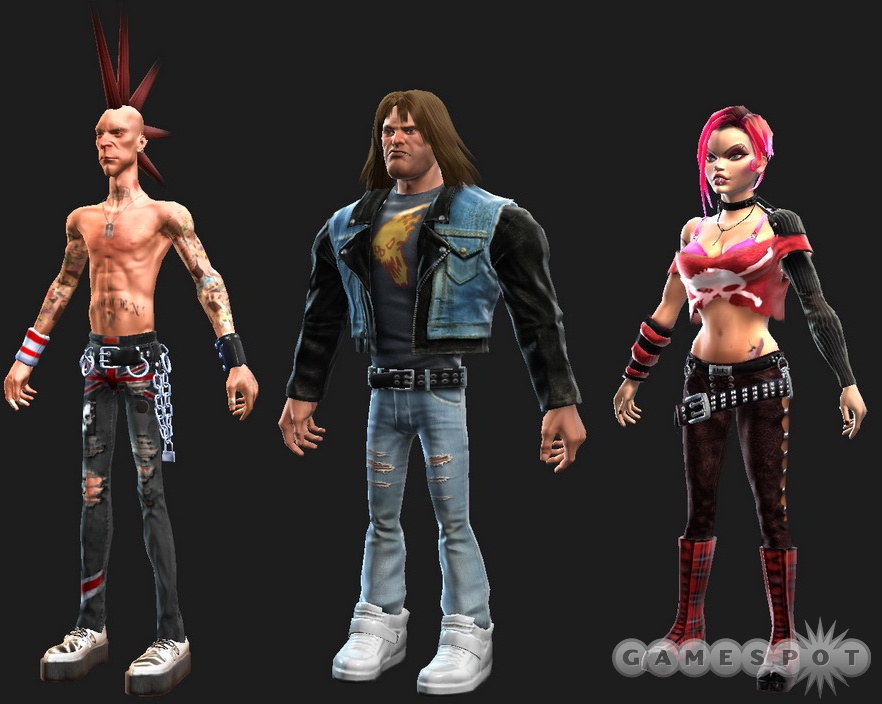Guitar Hero III Developer Diary #3
This guy gets to spend lots of time with Judy Nails and Casey Lynch. Read all about it inside.
Beyond the innovative gameplay and great soundtrack, one of the hallmarks of the Guitar Hero series has been its great cast of characters. From the sexy, spunky Judy Nails to the seriously scary Lars Ümlaüt, the axe-slingers in the music game series have always had loads of personality. In this, our third developer diary for Guitar Hero III (check out parts one and two), Chris George, lead character artist with Neversoft, gives us an overview of how the art team created and updated the characters that will be rocking your socks off when GHIII hits store shelves later this year.
Bringing Out Characters
By Chris George, Neversoft
My name is Chris George, lead character artist on Guitar Hero III: Legends of Rock. It has been an absolute blast working on this game and with everybody involved in making it. When creating these characters, our first priority was to retain the comical look of the original Guitar Hero and Guitar Hero II while actually bringing them into the current generation of graphics. We fired some ideas back and forth and finally settled on the idea of keeping the exaggerated proportions of each character, but creating materials and textures that looked and felt realistic. We believed this gave us the best shot at creating some characters that were really impressive without sacrificing the personality and style the franchise had established.

We had one character-concept artist on the team, Cameron Davis. He was responsible for the designs of every guitarist in the game, and this is where the process began. Cameron would create a few pages of thumbnail sketches for each character. Each design would be unique, yet fit within the rock style of that character. Quite often the designs were heavily influenced by real rockers that define that style. We would pick two designs for each character, one for the default outfit and an alternate that can be unlocked. The concept was then taken further, with highly detailed full-color paintings.
After the concept stage, the designs were handed over to one of the 3D character artists. There were three of us on Guitar Hero III: Legends of Rock including Mike Friedrich, Jason Maynard, and I. We began each character by modeling a low-poly base mesh in 3ds Max. This mesh would be similar to the final one used in the game, though [it] was more of a base model used to sculpt with in Zbrush. In Zbrush, we would subdivide and sculpt our high-poly detail mesh. Sometimes more high-poly details were created in 3ds Max, such as jewelry and belts. Frequently, our high-poly meshes ended up being more than six million polygons.
Once the high-poly modeling was finished, we would finalize the low-poly mesh and bake out our normal maps. From there, we would texture the model using various techniques to make each surface feel as realistic as possible. Our in-game pixel shaders are extremely flexible and go a long way to helping us create a wide variety of materials. These shaders were mostly developed during Tony Hawk's Project 8, so we had the benefit of being able to jump right in and play with settings to fit Guitar Hero's art style from day one.

When the model was done and the texturing was complete, we would create a basic skeleton that represented the character's proportions. This basic skeleton would get handed off to the animation department and a full rig based on those proportions would be generated. This gives every character in Guitar Hero III: Legends of Rock totally unique skeletons and proportions, which was a new experience at Neversoft. We were used to creating one skeleton and basing each character in the game off of those proportions. This method obviously gives us much more variety, and was necessary for this game since the character sizes vary greatly.
Most of the techniques I mention in this diary are industry-standard, and the production staff on the game was very organized, and it helped make our lives much easier when it came to scheduling. In the end, I feel very proud and confident of the art in our game. It was the talent and enthusiasm of the artists involved that made these characters look so great, and it was a pleasure to work with them.
Got a news tip or want to contact us directly? Email news@gamespot.com
Join the conversation